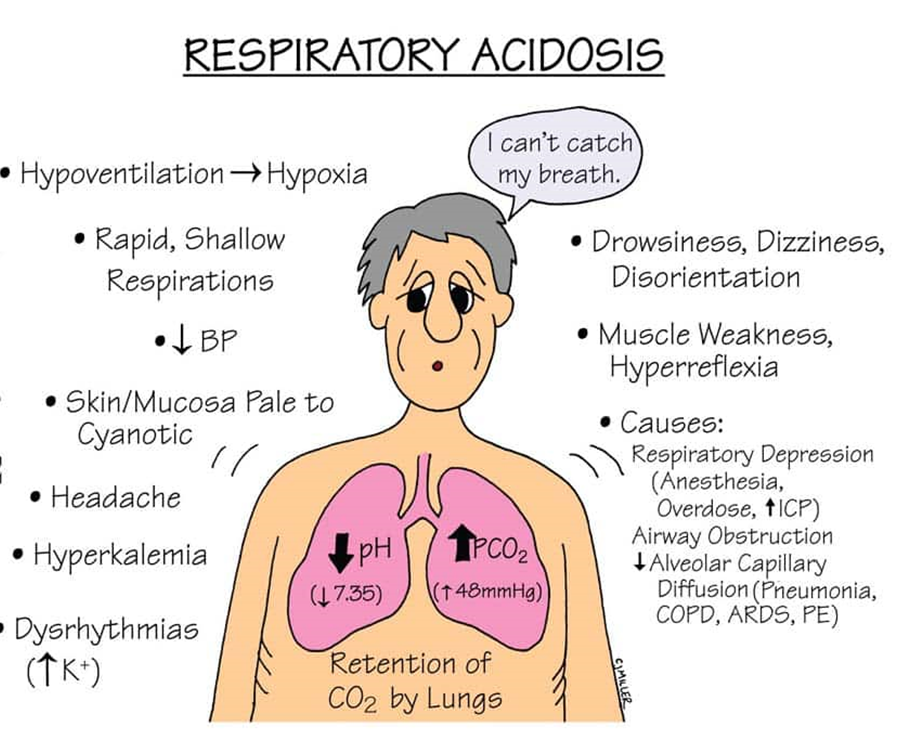The nurse understands causes of respiratory acidosis include: (SELECT ALL THAT APPLY)
asthma
hyperventilation
chronic obstructive pulmonary disease
renal insufficiency
pneumonia
Correct Answer : C,E
A. Asthma:
Explanation: Asthma is associated with respiratory alkalosis, not respiratory acidosis. In asthma, there is often hyperventilation leading to a decrease in carbon dioxide levels.
B. Hyperventilation:
Explanation: Correct. Hyperventilation can cause respiratory alkalosis, not respiratory acidosis. It leads to a decrease in carbon dioxide levels.
C. Chronic obstructive pulmonary disease (COPD):
Explanation: Correct. Conditions like COPD can lead to respiratory acidosis. In COPD, there is impaired ventilation, leading to an accumulation of carbon dioxide.
D. Renal insufficiency:
Explanation: Renal insufficiency is not a direct cause of respiratory acidosis. Respiratory acidosis is primarily related to respiratory system dysfunction.
E. Pneumonia:
Explanation: Correct. Pneumonia can cause respiratory acidosis. In pneumonia, there may be difficulty in eliminating carbon dioxide due to impaired gas exchange.

Nursing Test Bank
Naxlex Comprehensive Predictor Exams
Related Questions
Correct Answer is D
Explanation
A. Flushed skin: Flushed or warm skin is more characteristic of hyperthyroidism, where there is an excess of thyroid hormones.
B. Palpitations: Palpitations or a rapid heartbeat are more characteristic of hyperthyroidism, where there is an excess of thyroid hormones.
C. Bulging eyes: Bulging or protruding eyes, known as exophthalmos, is a characteristic sign of Graves' disease, which is a specific type of hyperthyroidism.
D. Fatigue: This is correct. Fatigue is a common symptom of hypothyroidism, reflecting the overall slowing down of the body's processes.
Correct Answer is D
Explanation
A. Management of diabetic ketoacidosis:
Diabetic ketoacidosis (DKA) is a severe complication of diabetes characterized by high blood sugar, ketones in the urine, and metabolic acidosis. While it's crucial to understand how to manage DKA, this may be considered more advanced knowledge and may not be categorized as a basic survival skill for someone newly diagnosed with type 1 diabetes.
B. Signs and symptoms of diabetic neuropathy:
Diabetic neuropathy is a long-term complication that involves damage to the nerves due to prolonged high blood sugar levels. While understanding neuropathy is important for long-term health, it may not be the first topic addressed as a basic survival skill for someone newly diagnosed.
C. Effects of surgery and pregnancy on blood sugar levels:
Understanding how surgery and pregnancy can affect blood sugar levels is important for managing diabetes in specific situations. However, this knowledge might be considered more advanced and may not be the initial focus for someone just starting to learn about diabetes self-care.
D. Recognition of hypoglycemia and hyperglycemia:
Recognizing the signs and symptoms of both low and high blood sugar is essential for immediate self-care. This includes understanding when blood sugar is too low (hypoglycemia) and requires prompt treatment, as well as recognizing the symptoms of high blood sugar (hyperglycemia) and knowing how to address them. This knowledge is fundamental for the daily management and well-being of someone with diabetes.
Whether you are a student looking to ace your exams or a practicing nurse seeking to enhance your expertise , our nursing education contents will empower you with the confidence and competence to make a difference in the lives of patients and become a respected leader in the healthcare field.
Visit Naxlex, invest in your future and unlock endless possibilities with our unparalleled nursing education contents today
Report Wrong Answer on the Current Question
Do you disagree with the answer? If yes, what is your expected answer? Explain.
Kindly be descriptive with the issue you are facing.
